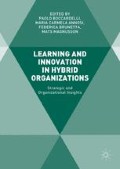Abstract
Business ecosystems are an emergent type of organizational form that can be defined as “the alignment structure of the multilateral set of partners that need to interact in order for a focal value proposition to materialize” (Adner in Journal of Management 2017). Gulati, Puranam, and Tushman (Strategic Management Journal 33(6): 571–586, 2012) have identified such ecosystems as a novel type of organizational form, which combines open membership boundaries with a highly stratified and more hierarchical decision making. Such new organizational forms are increasingly important in highly competitive global industries (Ilinitch, D’Aveni, and Lewin in Organization Science 7(3): 211–220, 1996; Volberda in Organization Science 7(4): 359–374, 1996). A key decision for firms managing a business ecosystem is how to design such governance decisions, as they can impact the rate and degree at which innovations arise and value is created. This chapter focuses on how firms manage these interdependencies with other actors that emerge in business ecosystems, and how the strategic management of such interdependencies affects innovation and value creation in business ecosystems.
Access this chapter
Tax calculation will be finalised at checkout
Purchases are for personal use only
References
Adner, R. (2017). Ecosystem as structure: An actionable construct for strategy. Journal of Management, 43(1), 39–58.
Carlile, P. R. (2002). A pragmatic view of knowledge and boundaries: Boundary objects in new product development. Organization Science, 13(4), 442–455.
Christensen, C. M., & Rosenbloom, R. S. (1995). Explaining the attacker’s advantage: Technological paradigms, organizational dynamics, and the value network. Research Policy, 24(2), 233–257.
Clarysse, B., Wright, M., & Bruneel, J. (2014). Creating value in ecosystems: Crossing the chasm between knowledge and business ecosystems. Research Policy, 43(7), 1164–1176.
Dalley, J., & Hamilton, B. (2000). Knowledge, context and learning in the small business. International Small Business Journal, 8(3), 51–59.
Demsetz, H. (1991). The theory of the firm revisited. In O. E. Williamson & S. Winter (Eds.), The nature of the firm (pp. 159–178). New York: Oxford University Press.
Du Plessis, M. (2007). The role of knowledge management in innovation. Journal of knowledge management, 11(4), 20–29.
Gawer, A., & Cusumano, M. A. (2002). Platform leadership: How Intel, Microsoft, and Cisco drive industry innovation (pp. 29–30). Boston: Harvard Business School Press.
Grant, R. M. (1996). Prospering in dynamically-competitive environments: Organizational capability as knowledge integration. Organization Science, 7(4), 375–387.
Gulati, R., Puranam, P., & Tushman, M. (2012). Meta organization design: Rethinking design in interorganizational and community contexts. Strategic Management Journal, 33(6), 571–586.
Hagel, J., & Brown, J. S. (2005). The only sustainable edge: Why business strategy depends on productive friction and dynamic specialization. Harvard Business Press.
Hecker, A. (2012). Knowledge beyond the individual? Making sense of a notion of collective knowledge in organization theory. Organization Studies, 33(3), 423–445.
Iansiti, M., & Levien, R. (2004). Strategy as ecology. Harvard Business Review, 82(3), 68–81.
Ilinitch, A. Y., D’Aveni, R. A., & Lewin, A. Y. (1996). New organizational forms and strategies for managing in hypercompetitive environments. Organization Science, 7(3), 211–220.
Kapoor, R., & Adner, R. (2012). What firms make vs. what they know: how firms’ production and knowledge boundaries affect competitive advantage in the face of technological change. Organization Science, 23(5), 1227–1248.
Kikoski, C. K., & Kikoski, J. F. (2004). The inquiring organization: Tacit knowledge, conversation and knowledge creations skills for 21st century organizations. Westport, CT: Praeger.
Kogut, B., & Zander, U. (1996). What firms do? Coordination, identity, and learning. Organization Science, 7(5), 502–518.
March, J., & Simon, H. (1958). Organizations. New York: Wiley.
Moore, J. F. (1993). Predators and prey: A new ecology of competition. Harvard Business Review, 71(3), 75–83.
Moore, J. F. (2006). Business ecosystems and the view from the firm. The antitrust bulletin, 51(1), 31–75.
Mäkinen, S. J., & Dedehayir, O. (2012). Business ecosystem evolution and strategic considerations: A literature review. In Engineering, Technology and Innovation (ICE), 2012. 18th International ICE Conference on (pp. 1–10). IEEE.
Nicolini, D., Gherardi, S., & Yanow, D. (Eds.). (2003). Knowing in organizations: A practice based approach. Armonk, NY: M. E. Sharpe.
Nonaka, I., Toyama, R., & Konno, N. (2000). SECI, Ba and leadership: A unified model of dynamic knowledge creation. Long Range Planning, 33(1), 5–34.
Pentland, B. T., & Rueter, H. H. (1994). Organizational routines as grammars of action. Administrative Science Quarterly, 484–510.
Polanyi, M. (1966). The tacit dimension. New York: Anchor Day.
Polanyi, M. (1969). The logic of tacit inference. In M. Grene (Ed.), Knowing and being. London: Routledge & Keagan Paul.
Schau, H. J., Smith, M. F., & Schau, P. I. (2005). The healthcare network economy: The role of Internet information transfer and implications for pricing. Industrial Marketing Management, 34(2), 147–156.
Seidler-de Alwis, R., & Hartmann, E. (2008). The use of tacit knowledge within innovative companies: knowledge management in innovative enterprises. Journal of knowledge Management, 12(1), 133–147.
Thomas, L. D. W., Autio, E., & Gann, D. M. (2014). Architectural leverage: putting platforms in context. Academy of Management Perspectives, 28(2), 198–219.
Thompson, J. D. (1967). Organizations in action: Social science bases of administrative theory. Piscataway: Transaction Publishers.
Tushman, M. L., & Nadler, D. A. (1978). Information processing as an integrating concept in organizational design. Academy of Management Review, 3(3), 613–624.
Volberda, H. W. (1996). Toward the flexible form: How to remain vital in hypercompetitive environments. Organization Science, 7(4), 359–374.
Weber, E. P., & Khademian, A. M. (2008). Wicked problems, knowledge challenges, and collaborative capacity builders in network settings. Public Administration Review, 68(2), 334–349.
Author information
Authors and Affiliations
Corresponding author
Editor information
Editors and Affiliations
Rights and permissions
Copyright information
© 2018 The Author(s)
About this chapter
Cite this chapter
Sherwani, H., Tee, R. (2018). Innovation and Value Creation in Business Ecosystems. In: Boccardelli, P., Annosi, M., Brunetta, F., Magnusson, M. (eds) Learning and Innovation in Hybrid Organizations. Palgrave Macmillan, Cham. https://doi.org/10.1007/978-3-319-62467-9_2
Download citation
DOI: https://doi.org/10.1007/978-3-319-62467-9_2
Published:
Publisher Name: Palgrave Macmillan, Cham
Print ISBN: 978-3-319-62466-2
Online ISBN: 978-3-319-62467-9
eBook Packages: Business and ManagementBusiness and Management (R0)

